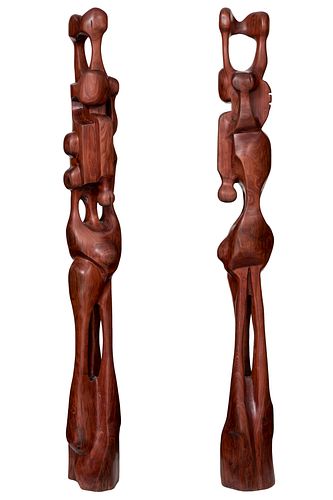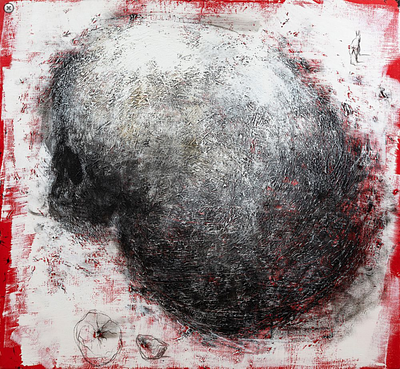AGUSTÍN CÁRDENAS ALFONSO (Cuba, 1927 - 2001). Untitled, 1955. Wood. Unique piece. Attached document signed by the widow of Don Odilio Urfé and cert
Lot 92
About Seller
Setdart Auction House
Carrer Aragó 346
Barcelona
Spain
Setdart Subastas was born in 2004 and is currently the first online art auction in Spain with solidity, prestige and reliability guaranteed by our more than 60,000 users. Setdart has a young, dynamic and enterprising team ready to successfully manage the purchase and sale of art works through custom...Read more
Categories
Estimate:
EUR€90,000 - EUR€100,000
$96,774.19 - $107,526.88
Absentee vs Live bid
Two ways to bid:
- Leave a max absentee bid and the platform will bid on your behalf up to your maximum bid during the live auction.
- Bid live during the auction and your bids will be submitted real-time to the auctioneer.
Bid Increments
| Price | Bid Increment |
|---|---|
| EUR€0 | EUR€10 |
| EUR€200 | EUR€25 |
| EUR€500 | EUR€50 |
| EUR€1,000 | EUR€100 |
| EUR€3,000 | EUR€200 |
| EUR€5,000 | EUR€500 |
| EUR€10,000 | EUR€1,000 |
| EUR€20,000 | EUR€2,000 |
| EUR€50,000 | EUR€5,000 |
About Auction
By Setdart Auction House
Oct 19, 2021
Set Reminder
2021-10-19 08:00:00
2021-10-19 08:00:00
America/New_York
Bidsquare
Bidsquare : CONTEMPORARY ART
https://www.bidsquare.com/auctions/setdart-auction-house/contemporary-art-7701
Setdart Auction House sofia@setdart.com
Setdart Auction House sofia@setdart.com
- Lot Description
AGUSTÍN CÁRDENAS ALFONSO (Cuba, 1927 - 2001). Untitled, 1955. Wood. Unique piece. Attached document signed by the widow of Don Odilio Urfé and certificate issued by Livia Cárdenas, the artist's wife. Provenance: "La Acacia" Gallery. Collection Don Odilio Luis Esteban Urfé. Signed and dated in the lower area. Measurements: 163 x 20 x 20 cm. This work belongs to the first stage of the artist where he stood out for his aesthetic experimentation with wood, used as a support and unique material for his works. The work is defined through forms that fluctuate between the figurative and the abstract, defined through a set of sinuous and organic lines that, when contemplating the sculpture, invite us to think of two lovers that merge together. The technique of the carving work evidences the harmony that the artist generates between matter and space. The result is an evocative work, which introduces the spectator into a world of insinuations, nuances and conceptual depth. It is not surprising that this type of work, which defined Cárdenas's artistic production, was called "Forms of Silence", the title of the artist's exhibition held at the Wilfredo Lam Centre in Havana. This particular work was part of the private collection of Don Odilio Luis Esteban Urfé, a renowned Cuban pianist and musicologist. A painter and sculptor, Cárdenas trained at the Escuela Nacional de Bellas Artes de San Alejandro, in Havana, between 1943 and 1949, where he studied under the guidance of the artist Juan José Sicre, who introduced him to the works of great sculptors such as Jean Arp, Henry Moore and Brancusi, which had a great influence on the development of his later work. Cárdenas was a member of the Association of Cuban Engravers (1951-55) and of the group Los Once (1953-55). In 1955 he was awarded a scholarship to study in Paris, the city where his most creative period took place, consolidating him as an international figure. In 1957 he joined the Parisian surrealist movement, and in 1965 he was awarded the prize at the Paris Biennial. As a sculptor, his work is divided into three stages, defined by the material used in each: first wood, then marble, granite and basalt, and finally bronze. His painting is closely related to his sculptural work, also presenting dynamic bodies that appear to be in constant change, with fluid and synthesised forms. Cárdenas exhibited his work both in Cuba and in the United States, France, Italy and South Korea, and participated in numerous group exhibitions, such as the Tokyo International Biennial in 1965. His awards include the Cuban National Prize for Plastic Arts (1955), although he has also been awarded several medals in Cuban fine arts salons, and in 1976 he won the prize at the Fujisankey Biennial (Japan) and was made a knight of the French National Order of Arts and Letters. Cárdenas is represented at the CNAC in Paris, the Hakone Art Museum (Japan), the National Museum of Fine Arts in Cuba, the Museums of Contemporary Art in Algiers and Montreal, the Museum of Modern Art in Tel Aviv and the Museum of Fine Arts in Caracas.
- Shipping Info
-
In-house shipping available. Please inquire at admin@setdart.com.
-
- Buyer's Premium



 EUR
EUR CAD
CAD AUD
AUD GBP
GBP MXN
MXN HKD
HKD CNY
CNY MYR
MYR SEK
SEK SGD
SGD CHF
CHF THB
THB

















